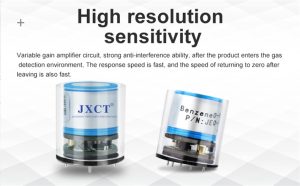Clean and healthy environments are essential for the well-being of individuals and communities. However, with increasing industrialization, urbanization, and vehicular emissions, air pollution has become a significant global concern. Poor air quality can have detrimental effects on human health, contributing to respiratory diseases, cardiovascular problems, and even premature death. To address this challenge, the role of gas sensors in ensuring clean and healthy environments has become crucial. Gas sensors, with their ability to detect and measure various harmful gases, provide valuable data for monitoring air quality and implementing effective pollution control measures. This article explores the significance of gas sensors in ensuring clean and healthy environments and their implications for public health and sustainable development.
Monitoring Air Quality:
Monitoring air quality is essential for understanding the levels of pollutants and their sources. Traditional monitoring methods often involve manual collection of samples, which are then analyzed in laboratories. However, these methods are limited in terms of time, location, and coverage. Gas sensors have revolutionized air quality monitoring by enabling real-time, continuous measurements of harmful gases such as nitrogen dioxide (NO2), ozone (O3), carbon monoxide (CO), sulfur dioxide (SO2), and volatile organic compounds (VOCs). By providing accurate and timely data, gas sensors empower policymakers, researchers, and communities to make informed decisions regarding air quality improvement strategies.
Early Detection of Pollution:
Gas sensors play a crucial role in early detection of pollution events. By continuously monitoring air quality parameters, gas sensors can quickly identify changes in pollutant levels and alert relevant authorities. This early warning system allows for prompt interventions to mitigate the harmful effects of pollutants. For example, if high levels of particulate matter or toxic gases are detected, authorities can issue public health advisories, initiate emission reduction measures, or implement traffic management strategies to minimize exposure risks. Gas sensors enable proactive measures to ensure clean and healthy environments.
Identifying Pollution Sources:
Gas sensors are instrumental in identifying pollution sources and hotspots. By strategically deploying sensors in various locations, patterns and trends in air pollution can be identified. This spatially-resolved data helps pinpoint specific emission sources such as industries, vehicles, construction sites, or biomass burning. With this information, policymakers can design targeted interventions that address the root causes of pollution, leading to more efficient and effective pollution control strategies. Gas sensors also facilitate research efforts in understanding pollutant dispersion patterns, optimizing urban planning, and implementing source-specific control measures.
Personal Exposure Assessment:
Gas sensors can be used for personal exposure assessment, providing individuals with real-time data on the quality of the air they breathe. Wearable gas sensors, integrated into devices such as wristbands or smartphones, enable individuals to monitor their immediate surroundings and make informed decisions regarding outdoor activities. This personalized approach to air quality monitoring empowers individuals to take proactive measures to protect their health and reduce exposure to pollutants. It also raises awareness about the importance of clean and healthy environments at an individual level.
Environmental Health Research:
Gas sensors contribute significantly to environmental health research. The data collected by these sensors helps researchers understand the long-term effects of air pollution on human health. By analyzing air quality data from different locations and correlating it with health outcomes, researchers can identify associations between specific pollutants and diseases. This evidence-based research is vital for informing public health policies, promoting pollution control measures, and advocating for sustainable development. Gas sensors provide a valuable tool for studying the impact of air pollution on public health.
Community Engagement and Citizen Science:
Gas sensors have the potential to engage communities and individuals in citizen science initiatives. Portable and affordable sensor technologies enable citizens to actively participate in air quality monitoring efforts. By equipping citizens with the tools and knowledge to measure air pollution levels in their neighborhoods, communities can raise awareness, advocate for policy changes, and contribute to long-term environmental improvement. Citizen science initiatives promote collaboration between researchers, policymakers, and the public, fostering a sense of engagement and shared responsibility in creating clean and healthy environments.
 : +86 155 8830 2704
: +86 155 8830 2704 : jxdziot@gmail.com
: jxdziot@gmail.com
